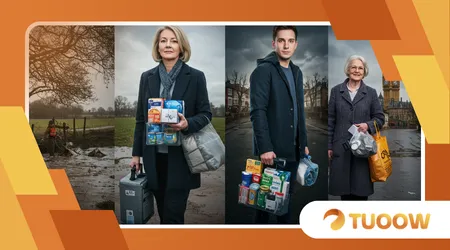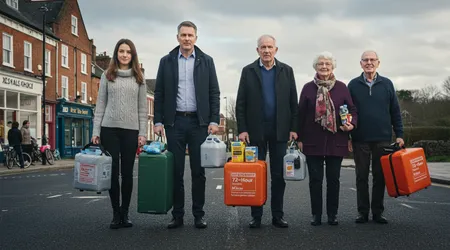UK Adopts Recommendations for 72-Hour Emergency Survival Kits

72-hour emergency survival kits are now a cornerstone of UK resilience, as the government urges households to brace for crises.
Launched via the “Prepare” website, this initiative responds to escalating threats blackouts, floods, or cyberattacks demanding self-sufficiency for three days. Why now?
Geopolitical tensions, climate disasters, and fragile infrastructure underscore the urgency.
In April 2025, former Deputy Prime Minister Oliver Dowden championed this shift, emphasizing practical readiness over panic.
This article unpacks the policy, its implications, and how Britons can act, blending urgency with actionable insights.
The call for 72-hour emergency survival kits isn’t mere bureaucracy it’s a lifeline.
Urban reliance on technology, coupled with vulnerabilities like gas pipeline sabotage fears, makes preparation critical.
A 2025 European Commission directive also pushed EU citizens toward three-day self-reliance, with the UK echoing this urgency.
This isn’t about doomsday prepping; it’s about pragmatism. From London flats to rural cottages, every household must adapt.
Let’s explore why this matters, what to include, and how to make it work.
Why the UK Needs 72-Hour Emergency Survival Kits Now
Geopolitical storm clouds loom large in 2025. Security advisors warn of Russian plots targeting UK energy pipelines, risking blackouts.
Last winter, the UK narrowly avoided power cuts, relying on Danish imports and reserves. Climate-driven floods and cyberattacks further expose infrastructure fragility.
The government’s “Prepare” site, launched in April 2025, addresses these risks head-on, urging 72-hour emergency survival kits as a buffer against chaos.
Households aren’t just preparing for abstract threats. Urban density amplifies risks gridlocked streets, strained services, and tech dependency turn crises into quagmires.
A 2025 study by the British Red Cross found 68% of UK adults feel unprepared for emergencies, yet only 12% have a plan.
This gap drives the push for 72-hour emergency survival kits, ensuring families can “bug in” rather than flee. It’s not fearmongering; it’s foresight.
++ UK Police Arrest Five Suspects in Major Counter-Terrorism Operation
Consider Sarah, a Manchester nurse. During a 2024 flood, she was stranded without food or power for two days.
A 72-hour emergency survival kit could have eased her ordeal, offering sustenance and light. Her story mirrors millions ordinary people caught off-guard.
The government’s call isn’t about paranoia but empowering resilience, ensuring no one faces a crisis empty-handed.

What Goes Into a 72-Hour Emergency Survival Kit?
The “Prepare” website lists essentials for 72-hour emergency survival kits, balancing practicality and affordability.
Water tops the list 2.5-3 litres per person daily, per WHO guidelines, with 10 litres ideal for cooking and hygiene.
Non-perishable foods like canned beans, tuna, or energy bars are vital. A battery-powered torch, radio, and spare batteries ensure communication and light.
Also read: Bird Flu Update: Latest Situation and Guidance for England
First aid kits, medications, and baby formula cater to specific needs. For example, a diabetic like Tom from Leeds requires insulin reserves in his kit.
The kit also includes sanitation items wet wipes, bin bags and warm clothing. Store these in a grab-and-go bag, marked with a bright ribbon, near your front door for quick access.
| Item | Quantity | Purpose |
|---|---|---|
| Bottled Water | 10L/person | Drinking, cooking, hygiene |
| Non-Perishable Food | 3 days’ worth | Sustenance |
| Battery/Wind-Up Torch | 1 per household | Illumination |
| Battery/Wind-Up Radio | 1 per household | News updates |
| First Aid Kit | 1 (plasters, antiseptic, etc.) | Minor injuries |
| Spare Batteries | For torch, radio, medical devices | Power backup |
| Warm Clothing/Blankets | 1 set/person | Warmth |
| Sanitation Items | Wipes, bin bags | Hygiene |
This table, drawn from Prepare.gov.uk, simplifies planning. Compact storage, like under-stair cupboards, suits small homes.
Gradually build your kit if budgets are tight add a few items monthly.
Read more: Government Launches AI Growth Zones and Green Jobs Training
Practical Tips for Building and Storing Your Kit
Space constraints challenge urban dwellers, yet solutions abound. A Brighton couple, Emma and Raj, store their 72-hour emergency survival kit in a hallway closet, using stackable plastic bins.
Compact foods like vacuum-sealed rice or dried fruit maximize space. Check expiry dates biannually rotate items to avoid waste. Accessibility matters; ensure everyone knows the kit’s location.
Think like a strategist: what’s your household’s weak point?
Pets, infants, or medical needs require tailored additions. For instance, pet food for a dog like Max ensures he’s cared for.
Budget-conscious? Buy in bulk during sales, but avoid overloading stick to three days’ worth. The “Prepare” site advises gradual accumulation, easing financial strain.
Engagement is key. Involve your family in planning, turning preparation into a team effort. Kids can help pack torches or label bags, fostering responsibility.
Ask yourself: if a blackout hit tonight, would you be ready? This isn’t just gear it’s peace of mind, a shield against uncertainty.
The Broader Implications of Preparedness
The push for 72-hour emergency survival kits reflects a cultural shift toward resilience. Unlike Cold War-era drills, this is about empowerment, not fear.
The British Red Cross’s 2025 data shows 68% of unprepared adults want guidance, signaling public appetite for clear advice.
The UK’s adoption aligns with EU strategies, fostering a bloc-wide preparedness ethos amid global instability.
This isn’t just about surviving it’s about thriving post-crisis. Communities with prepared households recover faster, easing pressure on emergency services.
Imagine a flood-hit village where every home has a kit: fewer panic calls, more self-reliance.
The government’s initiative isn’t a solo act; it’s a chorus, urging neighbors to support each other.
Yet, challenges persist. Rural areas face longer isolation risks, while low-income households struggle to afford supplies.
The “Prepare” site offers workarounds, like community bulk-buying or second-hand gear. This policy isn’t perfect, but it’s a bold step toward a nation ready for anything.
Overcoming Barriers to Preparedness

Skeptics might scoff another government edict, more clutter. But 72-hour emergency survival kits aren’t about paranoia; they’re insurance against the unexpected.
Cost is a hurdle, yet gradual stockpiling mitigates this. A single mum in Glasgow, Lisa, started with a torch and canned soup, building her kit over months. Small steps yield big results.
Misinformation also hampers efforts. Social media buzz trending on X in April 2025 sparked fears of imminent doom, misrepresenting the policy’s intent.
The “Prepare” site counters this, offering clear, jargon-free advice. Education is key: schools could teach kids about preparedness, normalizing it like recycling.
Accessibility matters too. Elderly or disabled Britons need tailored kits think easy-open cans or braille labels.
Local councils could distribute starter packs, bridging gaps. The goal?
A nation where preparedness is as routine as locking your door, not a privilege for the few.
A Nation Ready: The Path Forward
The UK’s embrace of 72-hour emergency survival kits is a wake-up call, not a siren of doom. It’s a policy rooted in reality climate chaos, energy risks, and global tensions demand action.
By equipping households, the government shifts the narrative from vulnerability to strength. Every kit is a brick in a resilient national wall.
Picture a fortress: each prepared home strengthens the whole. This isn’t about surviving alone but building a community that stands firm.
From Sarah’s flood ordeal to Tom’s insulin needs, these kits humanize preparedness, making it personal. The British Red Cross’s 68% statistic isn’t a failure it’s a challenge to act.
So, start today. Grab a bag, add water, a torch, some tins. Make it yours. The question isn’t if a crisis will hit, but when and whether you’ll be ready.
The UK’s future hinges on these small, vital steps toward self-reliance.
Frequently Asked Questions
Q: How much does a 72-hour emergency survival kit cost?
A: Costs vary, but a basic kit starts at £50-£100. Gradually add items like water (£10 for 10L) or canned goods (£1-£2 each) to spread expenses.
Q: Where should I store my kit?
A: Keep it near your front door, like a hallway closet, for quick access. Use stackable bins and mark with a bright ribbon for visibility.
Q: Can I customize my kit for specific needs?
A: Absolutely. Include pet food, baby formula, or medications (e.g., insulin). Tailor it to your household elderly, kids, or disabilities require unique items.
Q: How often should I check my kit?
A: Review every six months. Rotate food and water nearing expiry, test batteries, and update medications to ensure everything’s functional.
Q: Is this just for war or blackouts?
A: No, it’s for any crisis floods, storms, cyberattacks. The kit ensures self-sufficiency for 72 hours, whatever the emergency, as per Prepare.gov.uk.
